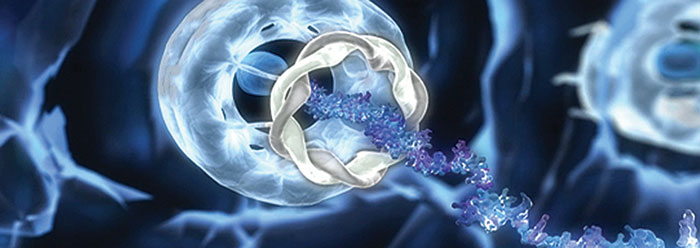One of the past arguments for evidence of biological evolution in the genome has been the concept of “pseudogenes.” These DNA sequences were once thought to be the defunct remnants of genes, representing nothing but genomic “fossils” in the genomes of plants and animals. However, copious amounts of new research—now publicly available in a variety of online databases and described in research publications—are rapidly showing how pseudogenes are not only functional, but key to organism survival.1
Pseudogenes come in several forms depending on their DNA sequence characteristics. One version is called the “unprocessed pseudogene,” which has all the normal parts of a protein-coding gene, but was originally thought to be incapacitated based on presumed DNA code errors. These are thought to have largely arisen as the result of being duplicated from another gene—a largely hypothetical explanation in most cases. A famous example of this type is the human “beta-globin pseudogene,” which has now been shown to functionally produce a variety of regulatory RNAs. It’s also required for proper blood chemistry. In fact, a variety of reports have shown that mutations in this gene are associated with various blood diseases.2,3,4
A recent news report on the beta-globin pseudogene is available on the Institute for Creation Research website, and an extensive ICR research project analyzing the scientific literature and functional genomics data for the beta-globin pseudogene has recently been submitted to a journal for publication.5
Another type is called a “processed pseudogene” because it lacks the intervening non-protein coding sequences called introns, which are typically spliced out when a messenger RNA (mRNA transcript) is produced from a gene. Because of this characteristic, evolutionists have postulated that processed pseudogenes arose from the sequence of an mRNA that was copied (reverse transcribed) and then re-inserted into the genome as a genetic accident. Another name for these types of pseudogenes is “retrogenes.”
Despite the still-prevalent myth that processed pseudogenes are also genomic fossils, scientists have been identifying important functions for these retrogenes in mammals since 1985.6,7 Another ICR news post describes the recent discovery of life-critical function for the human processed pseudogene (retrogene) PPM1K.8 Scientists realized that the PPM1K pseudogene was being actively transcribed, and when the cells of cancer patients were examined, the regulatory RNAs produced by PPM1K were found in abnormally low levels compared to healthy humans.9 The PPM1K pseudogene RNAs were not only found to help regulate the protein-coding version of the PPM1K gene, from which it supposedly evolved, but also the NEK8 gene that has also been associated with cancerous cell growth. Therefore, if this pseudogene is not functioning properly, cellular dysfunction and cancer are the likely result.
So why do these evolutionary predictions about the genome continually fail in the light of new research? It’s because scientists who possess an evolutionary mindset are always viewing the genome as the product of chance random processes. Instead, we should be looking at the genome from the perspective of pervasive functionality and incredible bioengineering—the product of an omnipotent and wise Creator.
References
- Wen, Y. Z. et al. 2012. Pseudogenes are not pseudo any more. RNA Biology. 9 (1): 27-32.
- Nuinoon, M. 2010. A genome-wide association identified the common genetic variants influence disease severity in beta0-thalassemia/hemoglobin E. Human Genetics. 127 (3): 303-314.
- Giannopoulou, E. et al. 2012. A Single Nucleotide Polymorphism in the HBBP1 Gene in the Human β-Globin Locus is Associated with a Mild β-Thalassemia Disease Phenotype. Hemoglobin. 36 (5): 433-445.
- Roy, P. et al. 2012. Influence of BCL11A, HBS1L-MYB, HBBP1 single nucleotide polymorphisms and the HBG2 XmnI polymorphism on Hb F levels. Hemoglobin. 36 (6): 592-599.
- Tomkins, J. Beta-Globin Pseudogene Is Functional After All. Creation Science Update. Posted on icr.org April 12, 2013, accessed May 12, 2013.
- Soares, M. B. et al. 1985. RNA-mediated gene duplication: the rat preproinsulin I gene is a functional retroposon. Molecular and Cellular Biology. 5 (8): 2090-2103.
- Ciomborowska, J. et al. 2013. “Orphan” Retrogenes in the Human Genome. Molecular Biology Evolution. 30 (2): 384-396.
- Tomkins, J. Pseudogene Plays Important Role in Cell Cycle. Creation Science Update. Posted on icr.org April 22, 2013, accessed May 12, 2013.
- Chan, W. L. et al. 2013. Transcribed pseudogene ψPPM1K generates endogenous siRNA to suppress oncogenic cell growth in hepatocellular carcinoma. Nucleic Acids Research. 41 (6): 3734-3747.
* Dr. Tomkins is Research Associate at the Institute for Creation Research and received his Ph.D. in Genetics from Clemson University.
Cite this article: Tomkins, J. 2013. Pseudogenes Are Functional, Not Genomic Fossils. Acts & Facts. 42 (7): 9.














